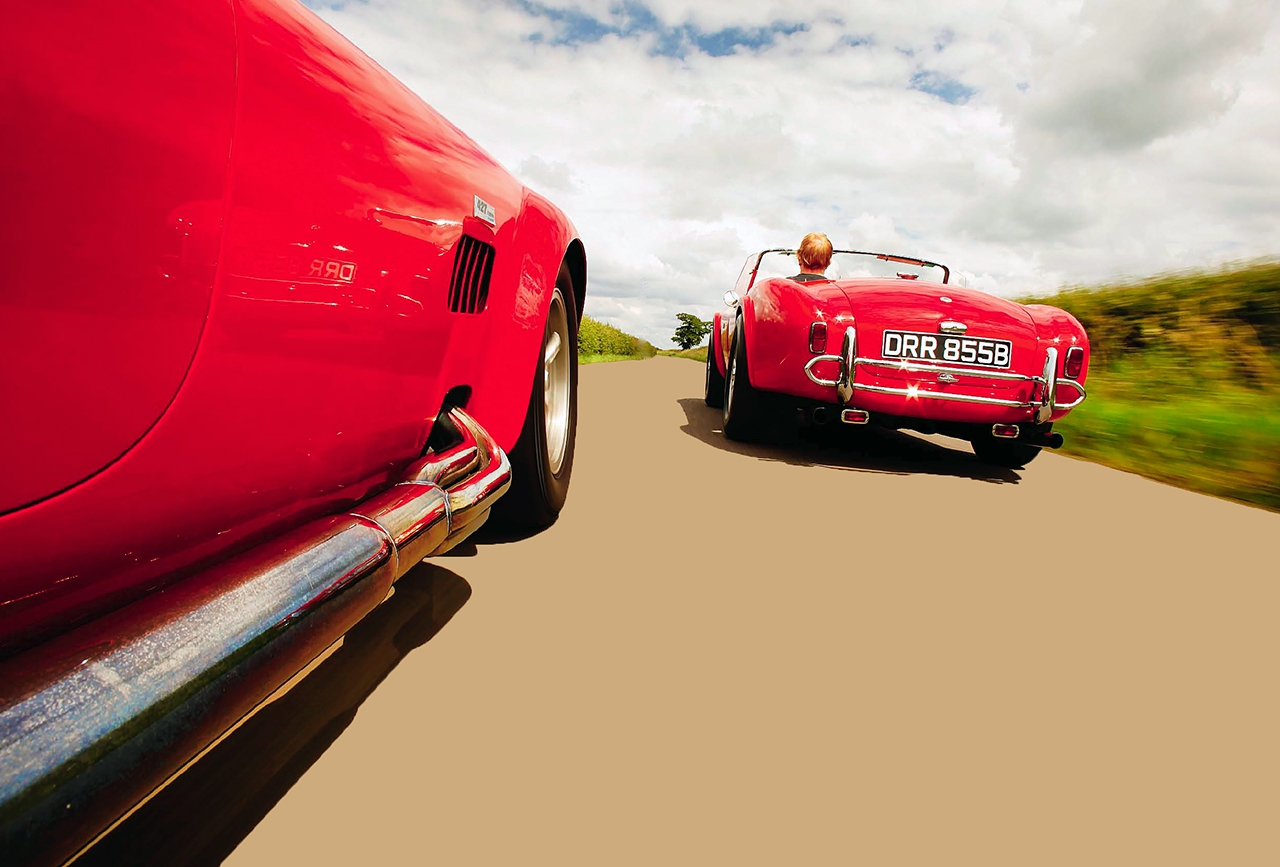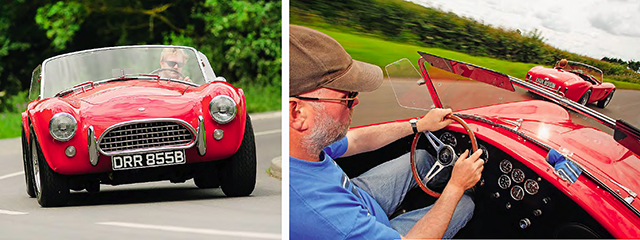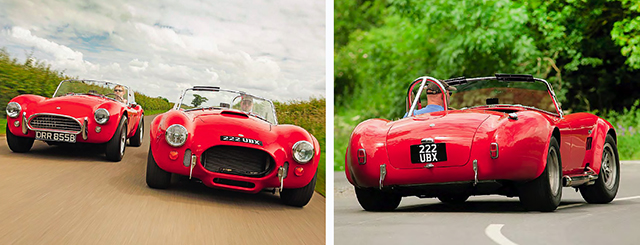
Thunder road. The Cobra has often been copied but never bettered, even after 53 years. Julian Balme re-ignites a lifelong love affair by driving a brutal Cobra 427 and the earlier 289 – photography Tony Baker. My father was responsible. One Saturday, he took his seven year-old son to Thames Ditton, a Surrey commuter village to the south-west of London, where he let him peer through the showroom windows of a modest high-street garage. The year was 1964, yet the machine I was confronted by looked to all intents and purposes to be from the previous decade. With my nose pressed against the glass, I could see a board pinned to the wall behind the open two-seater. It claimed that I was admiring ‘the world’s fastest accelerating sports car’, which was also capable of more than 150mph. Like every other kid in short trousers, I was totally smitten with the AC Cobra.
It’s hard to believe today, but back then there was little to satisfy the childhood lust provoked by this monstrously quick object of desire. There was no Corgi or Matchbox model; Dinky had an Aceca but that just wasn’t the same. Eventually Scalextric produced one as part of its drive to find popularity in the USA, but it was both expensive and limited as a toy.

The huge torque on offer from the 427 motor means that overtaking is swift and simple affair, but you can’t afford to relax for a second
The real thing was no more plentiful on UK roads, either. Of the first-generation leaf-sprung cars, only 47 right-hand-drive examples were produced and just 27 of all types of coil-sprung right-hookers. It’s hardly surprising that I never saw a Cobra on the street and I only ever recall spotting one in the car park at Silverstone.
There was, however, a constant stream of black-and-white photographs in Dad’s magazines. The press, particularly in the occasionally purchased American title Car and Driver, was ecstatic about my new favourite car. That first review recorded a 0-60mph time of a sneeze over 4 secs and the magic ton in under 10½. Not even James Bond had a car that fast.
A few years later, colour pictures of a Cobra graced my bedroom wall, by which time the car, equipped with an even larger V8, looked more aggressive. Flanked by huge exhaust pipes and shod with vast tyres, it was even faster, too: 0-100mph in 8.8 secs. What more could a kid possibly want from a car?

The 427 lacks any sort of delicacy next to the 289, a fact that is most strikingly illustrated by the rear view (far right)
By the early 1980s, along with the arrival of my driving licence, Cobra infatuation reached fever pitch. Weekends were spent watching the likes of John Atkins and Des Cassidy compete with their ACs in the HSCC’s Roadsports championship and, against cars 20 years their junior, in the Intermarque series. Rod Leach’s infamous twin-turbocharged ‘COB 1’ was a regular at the major classic-car shows. Books began to appear, John Christy and Dave Friedman’s Carroll Shelby’s Racing Cobra being a style bible for years to come, followed by Michael Shoen’s The Cobra-Ferrari Wars, from which I learnt more about the model’s competition pedigree, not least how instrumental a fair number of Brits were in its success. Even miniatures were being made, first by St Martins Accessories, which was swiftly followed by Box. On every level, bar one, my desire was finally being fulfilled.
Thirty years ago, a Cobra was advertised in these very pages for £25,000, a fraction less than the cost of my recently acquired studio flat in Maida Vale. It was a grim realisation: I’d never own a real ‘snake’. Today the Cobra has taken the lead in that particular race, with early road-car values starting at £300,000. In the following decade I enjoyed two brief drives: David Hescroff’s beautiful ex-works demonstrator, which, try as I might, simply didn’t accommodate my long legs; and the superbly sorted MkIII of Aidan Mills-Thomas.
The reality was, this first automotive love was now well and truly out my league. A brief fling at the inaugural Le Mans Classic behind the wheel of Kevin Kivlochan’s Cobra served only to underline the fact. A tsunami of replicas, modelled initially on the big-block cars and latterly the original, small-block version, went some way to cooling my ardour. For owners of both genuine and kit cars, the constant mantra of, “Is it a real one?” must have become almost as irritating as, “What does it do to the gallon?” But what finally broke my heart was the role of the Cobra in contemporary historic motor sport.
During the Noughties it had been akin to watching that first girlfriend become a huge movie star, only to be usurped by a tide of no less pretty but much younger and cheaper Eastern European lookalikes. I was over Cobras…
It is said that the divide between love and hate is pretty thin but, in recent years, I had certainly gravitated towards the latter where the 427 was concerned. As I approach John Stokes’ Rangoon Red example, I can only think of just how much the purity of the earlier car’s shape was compromised in an attempt to extend the model’s life.

Clockwise, from top: 427 needs a careful touch in corners; Halibrand alloys; forward-facing gearlever; monstrous powerplant. Clockwise, from top right: Hi-Po engine; left-hooker features American dials; dated suspension lacks finesse, 15in wire wheels.
The delicate, pert mouth became a slack-jawed, air-swallowing cavity with rosy cheeks, and its hips gained an unwieldy amount of weight that was matched only by that of the big-block Ford FE motor crammed under the bonnet. Shod with huge Halibrand alloy wheels – which, in the S/C spec found here, are 7½x15in up front, 9½x15in at the rear – the car looks every bit the beast of its reputation.
Just 348 of these second-generation cars were built, using an all-new coil-sprung chassis made from 4in-diameter twin tubes placed 20in apart. That represented an increase in width of 2½in over the original AC Ace Bristol-derived platform of the first Cobras. Covering the revised running gear, which included new upper wishbones plus revised front and rear locating structures, was a thicker .050in-gauge aluminium skin.
By necessity it ended up 5in wider than its predecessor but, as I step over the exhausts and slide into the cockpit, it is apparent that there had also been a small gain, front to rear, in the seating area. Fitting far more comfortably than I could ever have imagined, I crank the key to the left of the wood-rim steering wheel and wait for the engine to catch. Nothing could have prepared me for what happens next. What sounds like two Harley-Davidson outriders normally employed by Beelzebub explodes out of either side of the car. In my head I can hear Bill Cosby’s classic skit about his own rather special Cobra: “The car had not moved, I hadn’t put my foot on the gas pedal, yet it was killing people.”
Pushing the odd-looking, forward-facing gearstick into first, it is clear that the ’box has its origins in Ford’s truck department and yet, when I let out the clutch, I am amazed by how gentle it is. The throttle pedal, on the other hand, should carry a health warning. Possibly it’s the violent noise from the engine, but something tells you to exercise extreme caution with your right foot. In the 10 hours and 260 miles we spent together, not once did I put the pedal all the way to the floor. Instinct? Self preservation? I’m not sure, but anyone who tells you that they drive a 427 is a liar – it drives you. Pick a fight and there will be only one winner. It’s like being Peter Sellers in The Pink Panther: you’re never quite sure when Cato will attack and spit you off the road.
The source of all this potential mayhem is the 7-litre powerplant. A good number of these cars had the 428cu in Le Mans motor but, apart from the rocker-box covers, Stokes’ is actually an earlier 427 ‘top oiler’, many parts of which are dated 1963. Having been freshened up by Peter Knight, chances are that this car’s figures are now way in excess of the regular motor: 425bhp and 480lb ft in a car weighing just 2529lb. Not surprisingly, I soon learn that overtaking in this left-hooker is not a problem and, like being on the fairground ride that it really is, I actually giggle out loud the first time that I go to pass another car. The acceleration truly is that most over-used of American adjectives – awesome.
On the drive out west along the M4 to a date with one of its smaller-engined ancestors, I can’t help thinking that anyone who wanted to race a 427 must have been crazy. As we eat up the miles, however, it does occur to me that it would have been just about perfect as a tool to contest the Cannonball Run. That said, after a while I find the steering at high speed to be lighter than I’d want, the wheel gently vibrating between my fingertips – no doubt a symptom of the car’s wide tyres, which, in turn, make changing lanes far more of an adventure.
‘THE CLUTCH IS GENTLE, BUTTHE THROTTLE SHOULD REALLY CARRY A HEALTH WARNING’
At slow speeds, however, usually around petrol-station forecourts, it behaves impeccably, the steering being weighty but never a struggle.
The real revelation, though, is just how wellmannered this 150mph-plus car is in traffic. Encountering several jams on a rare warm, dry day, the hulking great V8 stays perfectly calm, save the tiniest amount of fuel evaporation, and happily retains all of its coolant thanks to a Kenlowe fan. I also avoid burning my ankles on the external exhaust pipes, apparently a badge of honour among big-block owners. Off the motorway and along country roads, the Cobra soaks up bumps with ease and, with the first tank of petrol spent, I am beginning to get worryingly comfortable, particularly when I realise that half an hour has passed without a single gearchange.
It’s the torque that gives the 7-litre its personality, both good and bad. Accelerate from 80mph and it will take off quicker than most cars from rest and yet move away from a junction in third gear, something I did more than once, and you’d barely notice. It’s far from sophisticated: there’s no multi-valve chatter or schizophrenic camshafts, just gobs of tree-pulling grunt. I am also beginning to think that I’ve been a bit harsh in my opinion of what, for most people, is the ultimate in Cobras – until, that is, we pull into the yard of Neil Dickens at The Hairpin Company. He has two small-block 289 cars: a right- and a left-hooker. Apart from it being a similar shade of red and lacking a bonnet scoop, the most outstanding feature of the left-handdrive car is my ability to fit behind the wheel, the result of my right leg only having to operate the throttle pedal from the ankle. All these years and it only required the steering wheel to be on the other side; well, that and a banker’s salary.
Nevertheless, it is still a snug fit and I’m amazed that a Texan of Carroll Shelby’s stature should have been happy with the lack of room. Dickens’ car wears a CSX chassis number (US cars were prefixed CSX; UK cars COB; and European ones COX) so the gauges are no longer Smiths, as in the 427, they are Stewart-Warner, and most of the switchgear is from a Ford Falcon. It’s these little touches of Americana that I find so intoxicating. The team Shelby attracted to his operation was among the most talented group of individuals ever assembled in one place. Forgetting the mechanics and drivers for a second, there were the likes of graphic artist and designer Peter Brock, illustrator George Bartel and in-house photographer Dave Friedman.
Those back pages stuffed full of all my heroes are encapsulated in this car. I haven’t even turned on the ignition and I’m getting pangs.
This example features the 289cu in V8 that, in Hi-Po guise with single four-barrel Holley carb, produced 271bhp – according to the brochures. Once on the move, it’s obvious that this car’s Peter Knight motor is putting out way more than that. The clutch is fiercer than in the bigblock, but the noise emanating from the engine isn’t so angry. It should be, because the much skinnier car feels almost as fast. Around the Wiltshire lanes, its buggy-sprung chassis lets it down slightly, banging and crashing after hitting even the smallest of potholes, but on smoother A- and B-roads it is a sheer delight. As with the larger car, roundabouts are an inconvenience best avoided, but with the 289 you just want to attack everyone that comes along. The driver is in control of the car, not the other way around, and, though both Cobras can be fun, you’d only want to marry the smaller of the pair. Do you, or indeed should you, ever get over your first love? Probably not.
Thanks to John Stokes; Guy Newton at Coys coys.co.uk; Neil Dickens at The Hairpin Company
The story behind ‘our’ cars
The true identity of John Stokes’ 427 Cobra is a little contentious, in that it has been deprived of a chassis number. The widespread belief among Cobra cognoscenti, however, is that it was rebuilt from the remains of the genuine ’66 car that was given a new chassis and body after an accident.
The original frame and shell were then acquired by a marque expert, who combined these components with period-correct drivetrain and parts.
The history of the 289 is much clearer, a trail of several owners having been well documented since it was first sold in Arizona. Originally white with a red interior, it moved around the States, acquiring a black paint-job along the way. In the late 1980s, it was restored for a Japanese collector who changed the colour to the red it wears today. By 1998, it had returned to Europe and was eventually bought by Frank Sytner in 2001.
| Car | Cobra 289 | Cobra 427 |
| Sold/number built | 1962-1964/654 | 1965-1966/348 |
| Construction | steel chassis with aluminium body | steel chassis with aluminium body |
| Engine | all-iron, ohv 289cu in (4735cc) V8, Holley four-barrel carb | all-iron, ohv 427cu in (6997cc) V8, Ford four-barrel carb |
| Max power | 271bhp @ 5800rpm | 390bhp @ 5200rpm |
| Max torque | 269lb ft @ 4800rpm | 475lb ft @ 3700rpm |
| Transmission | four-speed manual | four-speed manual |
| Drive | driving rear wheels | driving rear wheels |
| Suspension: | ||
| front | independent, by wishbones, transverse leaf spring | independent, by double wishbones, coil springs |
| rear | independent, by wishbones, transverse leaf spring | independent, by wishbones, coil springs |
| Steering | rack and pinion (worm and sector on early cars) | rack and pinion |
| Brakes | discs all round with servo | discs all round, with servo |
| Wheels | 15x6in 72-spoke wires | 15×7 1/2inch – 9 1/2inch alloys |
| Length | 12ft 10in (3912mm) | 13ft (3962mm) |
| Width | 5ft 1in (1549mm) | 5ft 8in (1727mm) |
| Height | 3ft 9in (1143mm) | 4ft 1in (1245mm) |
| Wheelbase | 7ft 6in (2286mm) | 7ft 6in (2286mm) |
| Weight | 2100lb (953kg) | 2529lb (1147kg) |
| 0-60mph | 5.6 secs | 4.2 secs |
| Top speed | 135mph | 165mph |
| Mpg | 15 | 9-12 |
| Price new | £2260 | £3500 |
| Price now | £300,000 | £500,000 |





